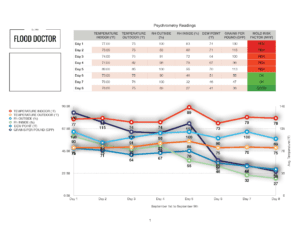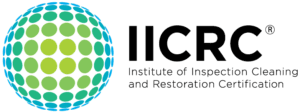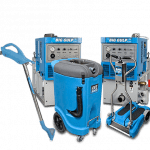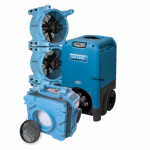Why should I use Flood Doctor for my water damage mitigation?
- We have been in business since 1999 and are a trained and experienced Water Damage Mitigation company and licensed General Contractors. We take great care during the dry-out process to protect and preserve your home’s contents and personal property.
- We also digitally document all aspects of our work, beginning with the dry-out. Please take a look at our Water Damage Restoration Process page.
I have water on my floors! What should I do?
Please look at our Water Damage Cleanup Tips section for an extensive list.
Here are a few snippets:
-
- Disconnect or unplug any electrical devices on the floor.
- If water is dripping from ceiling light fixtures, turn off the power at the circuit breaker.
- Remove as much of your furniture and contents as you can comfortably move.
Why should I use an IICRC Certified Restoration company to mitigate water damage?
The Institute of Inspection Cleaning and Restoration | IICRC sets water damage cleanup and restoration standards.
Flood Doctor Holds the following certifications from the IICRC:
Will mold or mildew be a problem?
By quickly responding, using professional drying equipment, and safe, EPA-approved antimicrobial products, we can prevent the growth of mold and mildew.
What are the health hazards of water damage in my home?
Water in your home is usually categorized as follows:
- Clean Water (CAT 1): This is water from your home’s plumbing system. This water source includes your sink, water heater, and washing machine. This water is generally clean and poses little risk.
- Gray Water (CAT 2) – This water might come from your dishwasher or bathtub and can cause illness.
- Black Water (CAT 3) is highly contaminated and usually comes from the toilet or sewer system. This water is dangerous to your health, and all surfaces that contact black water must be thoroughly cleaned, disinfected, or in most cases replaced.
How do you treat contaminated water from the toilet or sewer?
Most hard surfaces like tile and vinyl can be cleaned and sanitized. Porous materials like drywall, insulation, particle-board and paneling are typically removed.
How do you dry hardwood floors?
We use a commercial drying system designed specifically to dry hardwood floors. If we cannot dry your hardwood floors, we will remove the damaged wood and dry the sub-floor before replacing the hardwood
Is water damage covered by my insurance?
Usually, yes. Most insurance policies cover the cost of water damage mitigation. The easiest way to determine whether your water damage will be covered is to determine where the water came from.
As a rule of thumb, if water originates within your house, pipe breaks, toilet overflows, dishwasher leaks, it will be covered by your standard homeowner’s insurance policy. However, if water comes into your home due to a storm or clogged drain, then you would need additional Flood Damage Insurance.
Read your policy or ask your insurance agent about coverage and deductibles.
Can I turn off the equipment at night?
No, we ask you to leave the equipment running 24 hours a day.
If you turn off the equipment at night, the drying process is interrupted, and it will ultimately take longer to dry your home properly. Fast-drying of your home also reduces the chance of mold and mildew growth.
Why does it feel so dry in my house?
Water follows the rule of equilibrium: Wet will always want to go dry.
To ensure there is no trapped moisture anywhere in your home, we must make the air so dry that hidden moisture gets released into the air to reach equilibrium. Near the end of the Water damage restoration process, the indoor air will feel warm and dry. Your indoor plants may need additional watering.
Do you guarantee your work?
Yes, we guarantee, in writing, our workmanship for 2 years. The manufacturer usually guarantees any materials we use for one year, and we honor that guarantee.
Can I make changes or upgrades during the repair process?
Yes, you can. Your insurance company will pay for repairs and replacement of “like, kind, and quality.” If you choose to do upgrades, you will pay the difference yourself.
Why is there a foul odor in my home during the drying process?
Water on your carpets and in the pad can activate odors. This can be caused by dried pet urine, dirt, food, or other sources of contamination. After the drying portion of the restoration, your carpets will either be replaced, or we will have them professionally cleaned and deodorized.
Are any of the chemicals used harmful to my pets?
We use only safe, EPA-approved products in your home. Information on our antimicrobial chemicals is available on request.
Do I contact a contractor, or does Flood Doctor perform general contracting work?
You can hire us to perform any repairs that may need to be completed. If you choose to have someone else do the repairs, you are responsible for hiring a contractor yourself.
When will I hear from my insurance company?
Often, the adjuster will wait until the dry-out process is complete to assess damages. Because of our relationship with the adjuster, they may rely on our photos and scope of repairs without inspecting their own.
Will my electric bill go up because of the drying equipment?
We use modern energy-efficient drying equipment. If your insurance company is covering your water damage, they will also cover the price difference in your electrical bill.
- Axial Air Movers (fans)
- LGR (Low Grain Refrigerant) Dehumidifier
- Water Extraction & Removal tools
- Air movers, Dehumidifier, HEPA Air Scrubber
How often will you monitor the drying?

Dry-Log Sample
Unlike most other Water Damage Restoration Companies, We don’t need to schedule daily inspections.
We have brought over technology from the greenhouse industry and keep a close eye on environmental readings of your home remotely.
Data loggers and transmitters help us save you time and money in the mitigation process.
We may add or remove equipment depending on the data we look at. A graph of the hourly readings will be given to you and your adjuster.
What are my responsibilities during the dry-out process?
We ask you to notify us if a circuit breaker trips and the drying equipment shuts off so we can come out immediately and restart the drying process.
If my home and contents can’t be dried, will they be replaced?
After the dry-out process has been completed, we will determine what is damaged beyond repair.
We will then submit an estimate of repairs to your insurance adjuster for approval.
How long does the dry-out take?
The average dry-out takes between 3 to 7 days. If the structure has been exposed to water over a long period, it may take longer.
The amount of time it takes for your building materials to dry will depend on the following factors:
- Source of water
- Types of building materials
- Current weather conditions
- How quickly emergency services begin
- Location, duration, and source of water
After consistent monitoring and evaluation of the drying process, we will determine when it is completed.
Although your carpeting material may feel dry, it is possible that the sub-floor and padding may still be wet underneath. There are no specific rules in determining exactly how long it will take for your carpet to dry.
What is restorative drying?
In simple terms, restorative drying focuses on saving what can reasonably be saved; and thoroughly drying the structure. We then perform repairs to the structure, restoring it to pre-loss condition.
What is going to happen with my damaged furniture and or contents?
We will do our best to save your furniture and contents. If we cannot save your items, we will set them aside to be itemized and photographed. We will provide this documentation to your insurance company.
Can I do the repairs myself?
The most critical part of water damage is the drying process. After our trained and certified technicians have completed the dry-out, you may want to do the repairs yourself. We can bill your insurance company for the emergency repairs separately.
How do you know if everything is dry?
Our equipment is removing water from the structure and making it airborne. This evaporation causes the air to feel wetter.
We monitor the conditions indoors and out. We may open some windows if the conditions outside will help in the drying process. Otherwise, using our commercial dehumidifiers will notice much drier conditions in 24 to 48 hours.
We use state-of-the-art moisture detecting technology to check for proper moisture content specifically. We will not repair or replace any areas until we completely dry the structure.
How will filing an insurance claim affect my policy?
It is always best to check with your insurance company about the details of how a claim will affect your policy.
Do I need to call my insurance company first?
Not necessarily. Your insurance company would prefer that you try to minimize the damage to your home and contents.
We recommend that you call an emergency restoration company immediately. If professional water damage mitigation is started immediately, damage can be minimized, thus decreasing restoration costs. You should still contact your insurance company to make a claim.
Still, it would help if you did not wait for an adjuster or claim representative to arrive before calling a professional water damage restoration company.
Can you explain how the drying out process works?
Air movers push air across carpets, floors, walls, and all areas of your home, and this air movement changes water into an air-born vapor. This water vapor is then removed from the air by dehumidifiers, converted back into a liquid state, and pumped out of your home.
Please take a look at our Water Damage Restoration Process page.
How do I prevent mold?
Mold requires a constant supply of moisture and cellulose, a prime ingredient within all building materials.
- Keep humidity levels in your home as low as you can—no higher than 50%–all day long. An air conditioner or dehumidifier will help you keep the level low. You can buy a meter to check your home’s humidity at a home improvement store. Humidity levels change over the course of a day so you will need to check the humidity levels more than once a day.
- Be sure the air in your home flows freely. Use exhaust fans that vent outside your home in the kitchen and bathroom. Make sure your clothes dryer vents outside your home.
- Fix any leaks in your home’s roof, walls, or plumbing so mold does not have moisture to grow.
- Clean up and dry out your home fully and quickly (within 24–48 hours) after a flood.
- Add mold inhibitors to paints before painting. You can buy mold inhibitors at paint and home improvement stores.
- Clean bathrooms with mold-killing products.
- Remove or replace carpets and upholstery that have been soaked and cannot be dried right away. Think about not using carpet in places like bathrooms or basements that may have a lot of moisture.
Emergency?
Send us a service request and one of our project managers will contact you within minutes. Our Rapid Response units are typically on site within an hour of initial contact.




